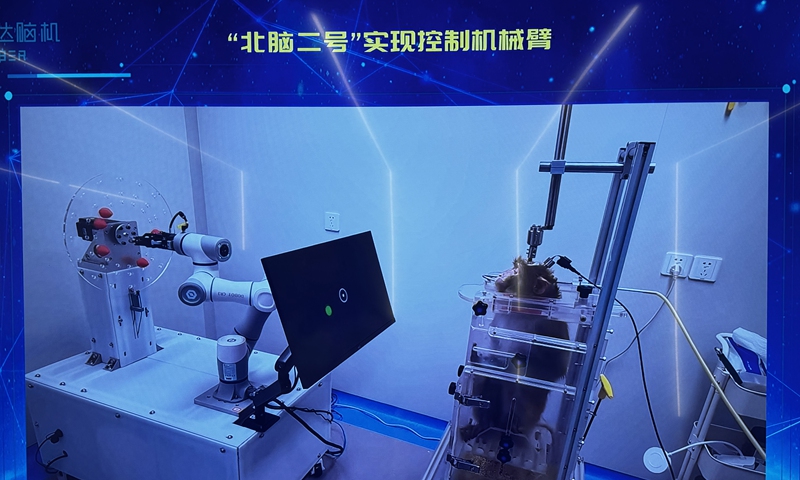China's version of Neuralink unveiled

A monkey with its hands tied up can control a robotic arm with "just its thoughts" through Neucyber. Photo: Liu Caiyu/GT
"China's version of Neuralink unveiled" - that's how observers described Neucyber, an invasive implanted brain-computer interface (BCI) technology, independently developed by Chinese scientists.
In its latest public appearance in April, through Neucyber, a monkey with its hands tied up can control a robotic arm with "just its thoughts" and successfully grasp a strawberry.
Recently, the Global Times visited the Chinese Institute for Brain Research in Beijing to witness the magical scene.
The wired Neucyber linking the monkey's brain is a system composed of three core components — high-throughput flexible microelectrodes, two high-speed neural signal acquisition devices and a generative neural decoding algorithm. It is able to capture subtle changes in the monkey's brain's electrical signals, decode the brain's intentions and achieve "thought" control of "actions."
The waving electrical signals on the screen are collected by the Neucyber, near the neurons of the monkey's brain, Zhang Lei, director of Instrumentation Core from the institute told the Global Times, pointing to the robust signals.
The flexible electrode has been stably implanted in the monkey's skull for nearly a year, and is still able to collect high-quality signals.
Following capturing signals, Neucyber will then decode the message with a decoding algorithm called "feedforward generative neural decoding algorithm," allowing the monkey to predict the moving target and control the robotic arm, Zhang said.
The advanced algorithm is a step forward to achieve the goal of creating neurally controlled prosthetics that are more human-like, natural and flexible for patients in the future. The team revealed that researchers are about to publish academic papers on the advanced algorithm-powered Neucyber.
Neuralink has already implanted its wireless brain chips in humans, while China has yet to begin human trials.
The Global Times learned that Chinese Institute for Brain Research is working on altering the wired BCI system into a fully implanted wireless invasive device, striving to start human trials next year.
Zhang said "While Elon Musk's startup Neuralink is considered the leading wireless BCI technology in practical use, our algorithm and electrodes are just as capable. However, the challenge lies in integrating the device into a small, discreet device that is safe for brains."
'Talk less, do more'
BCI technology is increasingly coming into view of the public, largely due to Elon Musk's Neuralink breakthrough. However, the roots of this technology actually trace back 50 years. The current top BCI technology in the world can decode 60 to 90 words per minute using brain signals, aiding high-level paraplegic patients in regaining mobility.
While China's BCI technology generally lags behind leading countries like the US in terms of system integration and clinical application, this has not hindered the release of Neucyber, which stands as China's first "high-performance invasive BCI."
The breakthrough lies in the efforts of the institute gathering superior resources from various teams in Beijing, Li Yuan, Business Development Director of Beijing Xinzhida Neurotechnology, the company that co-developed this BCI system, told the Global Times.
Developing the entire Neucyber system only took a year. Li explained that building the systematic project was possible because of a group of matured talents was gathered within the institute, from specific fields involving electrodes, chips, algorithms, software and materials.
In addition, the release of Neucyber is in line with China's overall strategy to develop BCI technology. Media reports have shown that China's supporting BCI technology has been clearly written within the national "14th Five-Year Plan" in 2020. The country's Ministry of Industry and Information Technology last year also classified BCI technology as an important "cutting-edge emerging technology."
To integrate the Neucyber into a small gadget like Neuralink, Li said multiple factors such as power supply, signal communication, power consumption, heat generation and size limitations should be taken into consideration.
"We do not want to be imaginative and talk too much, but strive to take out a set of products step by step that can be useful in actual application," Li told the Global Times.
Industry observers believe that since the BCI technology has not yet been widely used as medical devices globally, China still has the chance to industrialize its BCI products before the US.
In the application prospects, BCI devices are widely seen to be used in myoelectric prostheses which allow amputees to move more naturally and it is also expected to be used to treat neurological diseases, such as Parkinson's disease and stroke sequelae.
Furthermore, through wireless brain interfaces, small white rats and cockroaches can be controlled by animals with strong survivability in harsh environments, allowing them to help humans complete some special tasks, such as environmental monitoring and post-disaster rescue, Ye Zhewei, chairman of Intelligent Medicine Branch of Wuhan Medical Association was quoted by Changjiang Daily.
Producing dopamine and nerve cells is stimulated in neurological diseases such as depression and epilepsy. Soon, diseases such as epilepsy will be likely to be handled with more effective treatment, according to Ye.
Previously, China's prestigious Tsinghua University announced that Chinese scientists had made a breakthrough in the world's first patient BCI rehabilitation trial. The BCI technology device NEO (Neural Electronic Opportunity) was successfully implanted into a patient's brain for the BCI-assisted treatment trial at the Xuanwu Hospital in Beijing, on October 24, 2023.
China has also achieved a technological breakthrough in the chip flux of BCI. For example, Wuhan Zhonghua Brain-Computer Integration Technology Development successfully developed 65,000 two-way BCI chips, ranking at the international leading level, Ye said.
The development prospects of sensors, wireless transmission methods and chip functions are also very huge in China, Ye noted, which is the confidence of China to further advance the BCI technology.
Photos
Related Stories
- Elon Musk's Neuralink gets FDA approval for in-human clinical study
- Brain-machine integration spawns global biz race
- Proportion of Chinese citizens with scientific literacy reaches 14.14 pct
- Hong Kong researchers pioneer new stem cell platform for immunodeficiency treatment
- "Bridge" in place, China ready to sample on moon's far side
- Prototype of intelligent humanoid TongTong to be unveiled
Copyright © 2024 People's Daily Online. All Rights Reserved.









